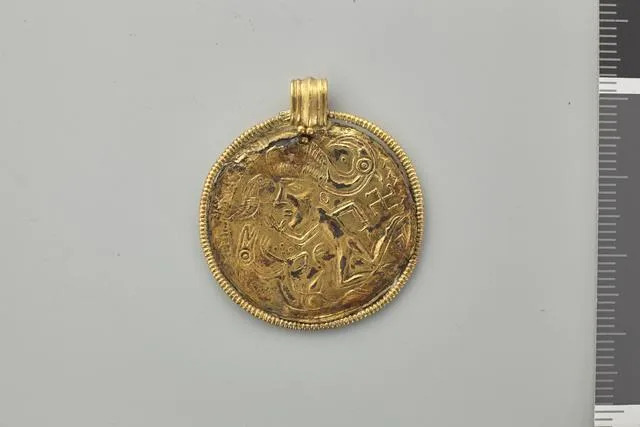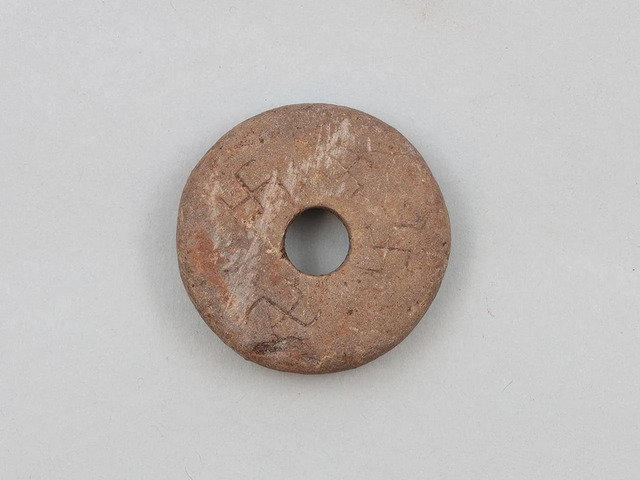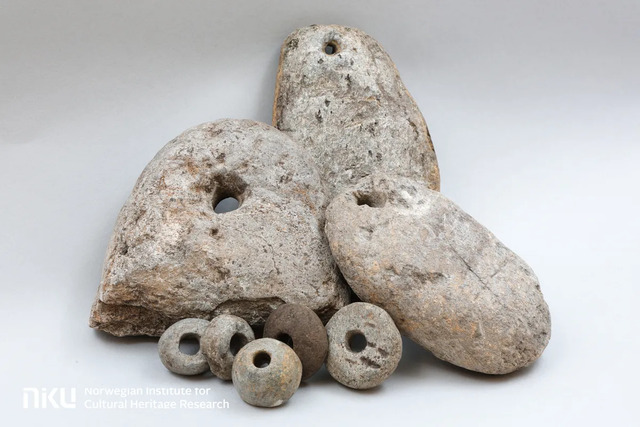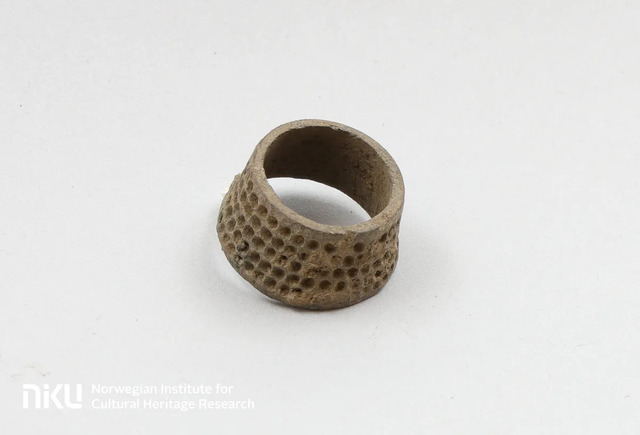Hidden beneath layers of history, a 13th-century spinning whorl adorned with swastika carvings has emerged from the soil of Tønsberg, Norway. This unassuming artifact, unearthed by archaeologists during routine excavations, is a gateway to understanding the craftsmanship, daily life, and symbolic traditions of medieval Scandinavia. Its intricate design challenges modern misconceptions and offers a profound connection to a time when every object carried deeper meaning.
The Discovery in Tønsberg
The excavation was conducted by the Norwegian Institute for Cultural Heritage Research (NIKU) as part of a project to upgrade street infrastructure in Tønsberg, a town steeped in history. Among the artifacts recovered was the spinning whorl, made of red sandstone and bearing four swastikas: three right-facing and one left-facing. This intriguing object was found between two floor layers in a weaving room, alongside other tools of the textile trade, such as loom weights, thimbles, and a decorated antler object likely used in weaving.
The room where the whorl was found was likely a space for domestic or small-scale textile production rather than an industrial operation. Hanne Ekstrøm Jordahl, the lead archaeologist on the project, confirmed the artifact’s medieval origin, dismissing any associations with the swastika’s 20th-century appropriation by the Nazis. “The swastikas were carved during the Middle Ages,” Jordahl explained, adding that their context is rooted in the era’s cultural and symbolic traditions.
An intriguing spinning whorl featuring swastika symbols has been uncovered in Tønsberg – watch the video to explore this fascinating discovery!
Understanding the Swastika Symbol
The swastika is an ancient and widespread symbol that has appeared in cultures across Europe, Asia, and the Americas for thousands of years. In its original context, the swastika was a symbol of prosperity, good fortune, and solar energy. Archaeological evidence shows that it was used as a decorative and spiritual motif in Iron Age Scandinavia and throughout the medieval period.

In Norway, swastikas have been found on gold pendants, rock carvings, textiles, and even stave churches. These artifacts demonstrate that the symbol was a meaningful part of Scandinavian heritage long before it was tarnished by its 20th-century misuse. Jordahl emphasized this point, noting that “examples of prehistoric swastikas in Norway are not hard to find,” though their presence on a spinning whorl is unprecedented.
The Spinning Whorl: A Medieval Textile Tool
A spinning whorl is a small, weighted object with a central hole, designed to fit onto a spindle. By providing momentum to the spindle, the whorl made it possible to spin thread from fibers such as wool or flax. This essential tool was a cornerstone of medieval textile production, used by women and men alike in crafting the threads that formed the basis of clothing, sails, and other necessities.

The Tønsberg whorl stands out not only for its carved symbols but also for its craftsmanship. Made from red sandstone, it features a flat top and base with rounded sides. The addition of swastikas suggests that the tool carried symbolic significance beyond its practical use. Perhaps the swastikas—symbols of rotation and cyclic movement—were seen as metaphors for the spinning process itself, linking the act of creation to broader cosmic and spiritual cycles.
Textile Production in Medieval Scandinavia

Textile work was a vital part of daily life in medieval Scandinavia, encompassing spinning, weaving, and sewing. The tools found in Tønsberg, including loom weights and thimbles, reflect the importance of these activities. Loom weights, for example, were used to maintain tension in warp threads on a loom, facilitating the weaving of cloth. Copper alloy thimbles protected fingers during sewing, while decorative antler tools, like the one found at the site, added an artistic touch to the craft.
The spinning whorl’s discovery adds to this picture, highlighting the skill and creativity of medieval artisans. These tools were not merely functional; they were often embellished, reflecting the cultural and aesthetic values of their makers.

Symbolism of the Swastika on the Whorl
The swastikas carved into the spinning whorl may have held multiple layers of meaning. In medieval Scandinavia, the swastika’s arms were often associated with the sun’s rays, representing time, movement, and renewal. On the whorl, this symbolism could align with the spinning motion, evoking the cyclical nature of life and the universe.
Additionally, the swastika’s presence on a tool used for creating textiles may reflect the cultural significance of weaving and spinning in medieval society. These activities were not only practical but also deeply symbolic, tied to myths and rituals. In Norse mythology, for instance, the Norns—goddesses of fate—were often depicted as weavers, spinning the threads of destiny. The swastikas on the whorl could thus symbolize good fortune and protection, ensuring the success of the spinner’s work.
Comparison with Similar Finds
While swastikas are common in Scandinavian artifacts, their presence on a spinning whorl is unusual. Other examples of swastikas in Norwegian archaeology include gold bracteates, rock carvings, and textiles from grave sites. The Oseberg ship burial, for instance, yielded textiles with woven swastika patterns, demonstrating the symbol’s significance in both decorative and ritual contexts.
The Tønsberg whorl’s unique combination of form and symbolism sets it apart from other finds. It serves as a rare example of how everyday objects could carry profound cultural meanings, bridging the practical and the spiritual.
Video
Step into history with a look at ancient whorls and spindle sticks – watch the video to uncover the story behind these timeless artifacts!
Conclusion
The 13th-century spinning whorl discovered in Tønsberg is more than just a tool; it is a window into the lives, beliefs, and artistry of medieval Scandinavians. Its swastika carvings challenge modern perceptions of the symbol, reminding us of its ancient roots as a sign of good fortune and cosmic order. Through careful study and preservation, artifacts like this whorl deepen our understanding of history and the complex interplay between culture and craftsmanship.
As we uncover more about the past, the Tønsberg whorl stands as a testament to the enduring legacy of symbols and the universal human desire to imbue everyday objects with meaning. It invites us to reexamine history with an open mind, appreciating the richness and diversity of our shared heritage.
